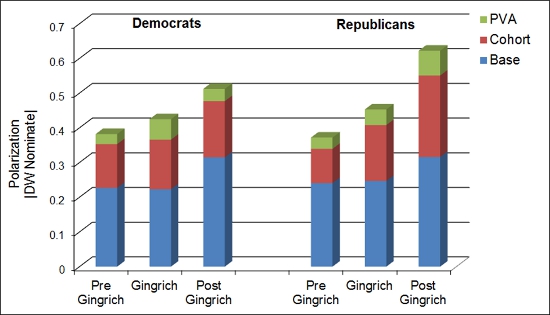 Anyone observing the US Senate recently would have noticed that it has become a more ideologically extreme place, something that has also been confirmed by academic studies. But why is the Senate now exhibiting the same extreme behavior and polarization that the House of Representatives is well known for? In new research, Jordan Ragusa argues that much of the Senate’s polarization is due to the fact that it has some of the same members as the House. He writes that lawmakers learn extreme behaviors in the House that continue with them once they are elected to the Senate.
Anyone observing the US Senate recently would have noticed that it has become a more ideologically extreme place, something that has also been confirmed by academic studies. But why is the Senate now exhibiting the same extreme behavior and polarization that the House of Representatives is well known for? In new research, Jordan Ragusa argues that much of the Senate’s polarization is due to the fact that it has some of the same members as the House. He writes that lawmakers learn extreme behaviors in the House that continue with them once they are elected to the Senate.
In the American political lexicon, the Senate is said to possess “coolness” and “wisdom.” Words like “decorum,” “comity,” and “respect” are frequently used to describe the institution as well. In recent years, however, cracks have appeared in the Senate’s high-minded veneer. For example, in July of this year, Ted Cruz was admonished by his own party for calling Majority Leader Mitch McConnell a “liar” on the Senate floor. A number of political observers have remarked that senators seem to be behaving more like the “uncivilized masses” in the House of Representatives.
Academic studies confirm that the Senate has become a more extreme place over the past two decades. Indeed, by just about any measure, the Senate has polarized ideologically at about the same rate as the House. According to political scientist Keith Poole, both chambers are more polarized than at any period since the late 1800s. What’s puzzling about the synchronous polarization of the House and Senate is the fact that the chambers should respond the polarizing pressures very differently. With longer terms and more diverse constituencies, senators should move toward the extremes at a much slower rate than the representatives.
All this begs the question: Why do we see similar patterns of polarization in both chambers?
Although the House and Senate are quite different from electoral and institutional standpoints, they share one important thing in common: the same members. In the current Senate, about half of senators first served in the House. Examples include staunch liberals like Barbara Boxer and Dick Durbin as well as staunch conservatives like James Inhofe and David Vitter. Notably, this seems to be a modern development. In the 80th Congress (1947-1949), just 19 percent of senators came from the House.
Can the increase in the volume of shared members explain the Senate’s polarization?
In new research, I argue that it can. In the paper I argue that lawmakers learn extreme partisan behaviors in the House and simply continue those learned routines after winning election to the Senate. Although this theory has intuitive appeal and fits the timing of the Senate’s polarization, it is unconventional in the congressional literature. Indeed, virtually all studies view polarization as a function of lawmakers’ rational or goal-seeking actions (designed to secure preferable policy outcomes or win re-election). In contrast, my work theorizes that lawmakers’ roll-call behaviors are also the product of social-psychological processes.
I propose that there are two main ways this “partisan learning” happens. First, political parties use their organization powers to intentionally socialize junior members. What junior members learn in this context is the utility of party loyalty and a norm valuing teamsmanship. While uncommon in the contemporary congressional literature, papers by Sinclair, Loomis, and Dodd make similar arguments. Second, lawmakers learn partisan behaviors as a by-product of the House’s hyper-partisan environment. Political scientists Arthur Lupia and Matt McCubbins summed it up best: “Legislators, like most people, learn by watching what others do and listening to what they say”.
I test the theory of partisan learning in a series of statistical models. In simple terms, the models tell us why some senators are so extreme in their voting behavior and others are relatively moderate. A key aspect of these models is that they account for the “usual” explanations of polarization (things like party identification and state characteristics). More importantly, however, they account for possible selection effects caused by electoral dynamics (maybe extremists are more likely to run for the Senate?) as well as a senator’s ideological extremism before they won election to the House.
Ultimately, the results validate the theory that senators adopt partisan behaviors in the House and continue those behavioral patterns after winning election to the Senate. Among results, I find that senators who came from the House display greater ideological extremism if they (a) served in the House within an extreme partisan cohort and (b) won election to the Senate after representing a partisan district. In other words, ideological extremism is fostered when lawmakers are surrounded by extreme co-partisans as well as when they represent extreme constituents.
Figure 1 shows just how substantively important the two factors are for Democrats and Republicans. In the figure, the causes of ideological extremism are broken down by era according to whether a senator served before Newt Gingrich was elected in 1978, during Gingrich’s time in the House, and after Gingrich resigned in 1999. The blue “base” causes of a senator’s ideological extremism represent the “usual”. Needless to say, factors like party identification and state characteristics have the biggest overall effects in both parties and in every time period. At the same time, however, we can see that the effect of a senator’s House cohort (red bar) is quite large as well. This effect is most visible on the Republican side in the post-Gingrich era, where the cohort effect accounts for roughly 35 percent of a senator’s ideological extremism.
Figure 1 – Ideological extremism in the Senate by era

Note: PVA refers to Presidential Vote Advantage
It is important to note that my paper is not the only one that documents these patterns. Sean Theriault and David Rohde were the first to report that the replacement of moderate senators by extremists from the House has been a major cause of the Senate’s polarization. And Theriault followed up on that article with an excellent book on the same topic. But like most landmark studies, their work raised additional questions. Namely, neither project was able to isolate what–exactly–happens in the House that causes ideological extremism in the Senate. In a review of Theriault’s book, political scientist Gerald C. Wright noted the following:
“More could be done to address the question of why these senators are so different. Theriault deals with the question indirectly in some rough quantitative controls for state characteristics, but he does not confront the question head on.”
In both projects, Theriault and Rohde refer to the House’s effect on Senate polarization as a consequence of a peculiar cohort of lawmakers they call the “Gingrich Senators”. In simple terms, their work identifies senators who came from the House after Gingrich’s election (from 1978-2010) as key to explaining the Senate’s polarization. My results, by comparison, show that the underlying causes of this effect are not isolated to Newt Gingrich or the Republican Party but are, instead, part of a more broadly generalizable behavioral process. In fact, some of the most partisan senators in the past decade (Jim DeMint, Pat Toomey, and David Vitter) entered in the House after Gingrich had resigned.
In the end, I prefer the term the “Housification” of the Senate. It may seem like academic quibbling over vocabulary, but the distinction has important implications for why the Senate has polarized as well as our theoretical understanding of legislative behavior. In my view, legislative behavior is not just the product of rational, goal-seeking motivations. Congressional behaviors–like ideological extremism–can be learned as well.
This article is based on the paper, ‘Partisan Cohorts, Polarization, and the Gingrich Senators’ in American Politics Research.
Featured image credit: United States Government
Please read our comments policy before commenting.
Note: This article gives the views of the author, and not the position of USAPP – American Politics and Policy, nor of the London School of Economics.
Shortened URL for this post: http://bit.ly/1i36eMJ
_________________________________
 Jordan Ragusa – College of Charleston
Jordan Ragusa – College of Charleston
Jordan Ragusa is an assistant professor of political science at the College of Charleston. His research and teaching interests are in the fields of American politics and institutions, political behavior, political economy, empirical theory, and research methodology. For more information, visit his research page. In addition to his academic writing, Ragusa is also the co-author of the American politics blog Rule 22 and is a regular contributor at the Christian Science Monitor.-







4 Comments